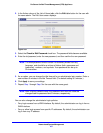
Network and System Management
440
ProSecure Unified Threat Management (UTM) Appliance
Note: If you are unable to connect remotely to the UTM after enabling
HTTPS remote management, check if other user policies, such as
the default user policy, are preventing access. For access to the
UTM’s web management interface, check if administrative access
through a WAN interface is granted (see Configure Login Policies on
page 404).
Note: If you disable HTTPS remote management, all SSL VPN user
connections are also disabled.
Tip: If you are using a Dynamic DNS service such as TZO, you can identify
the WAN IP address of your UTM by running tracert from the
Windows Run menu option. Trace the route to your registered FQDN.
For example, enter
tracert UTM.mynetgear.net, and the WAN IP
address that your ISP assigned to the UTM is displayed.
Use a Simple Network Management Protocol Manager
Simple Network Management Protocol (SNMP) forms part of the Internet Protocol Suite as
defined by the Internet Engineering Task Force (IETF). SNMP is used in network
management systems to monitor network-attached devices for conditions that warrant
administrative attention.
SNMP exposes management data in the form of variables on the managed systems, which
describe the system configuration. These variables can then be queried (and sometimes set)
by managing applications.
SNMP lets you monitor and manage your UTM from an SNMP manager. It provides a remote
means to monitor and control network devices, and to manage configurations, statistics
collection, performance, and security.
To configure the global SNMP settings and SNMPv1/v2c settings:
1. Select Administration > SNMP. The SNMP screen displays:


















